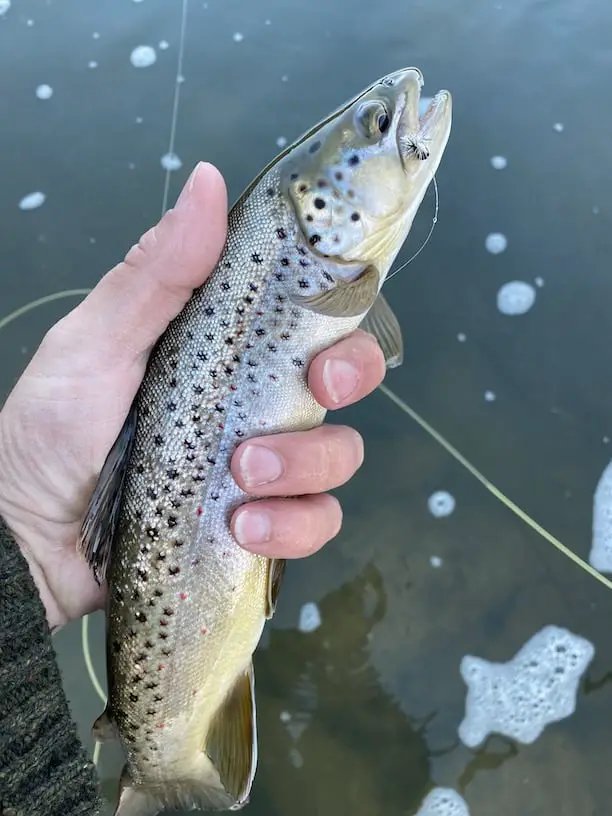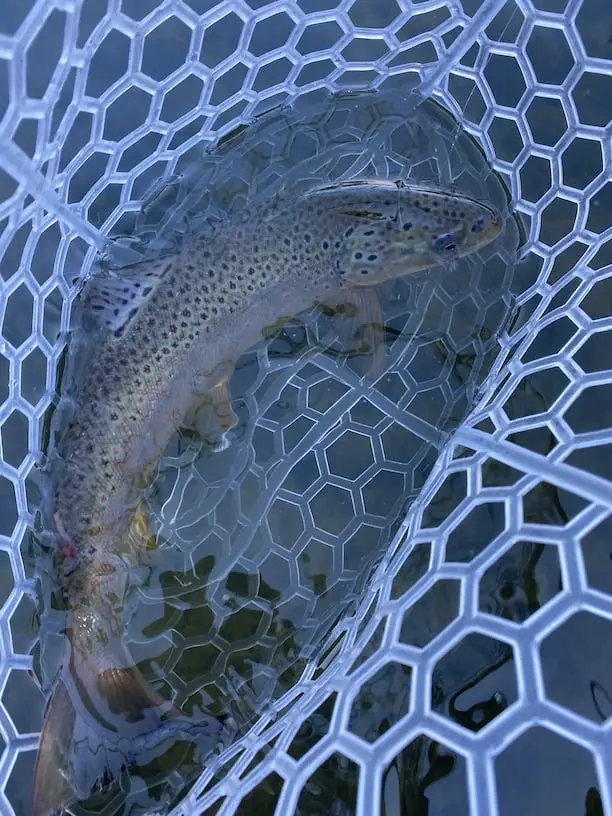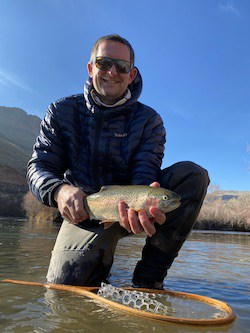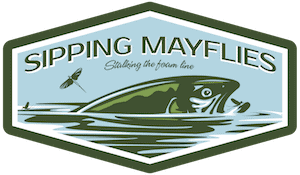TIPS FOR FLY FISHING WITH ANTS [Including Flying Ants]
Nov. 28th, 2021
The ant pattern is the best fly you’ve never used. In fact, most fly anglers haven’t.
The reason is, we’re told that we’re supposed to “match the hatch,” and naturally we think of mayflies, caddisflies, and stoneflies. The prolific bugs we see flying around in front of our eyes.
The thing is, ants are ever-present during certain seasons too, and trout relish them. While fly fishing in the U.S. you’ll see normal black ants, flying ants, carpenter ants, and velvet ants. Fly fishing with ants is an extremely productive method, and I’ll teach you everything you need to know to have a great day on the water.
In this article I’m going to explain to you why and where trout eat ants, how and when to fish ant patterns, and the best ant flies available.
I’m going to operate under the impression that you already understand the basics of fly fishing, such as the need for a drag-free drift. All the usual dry fly principles apply to casting ants.
Here’s a picture of a brown trout that took my parachute black ant fly.

Why Do Trout Eat Ants?
The quick answer is no one knows.
One distinguishing characteristic of ants is that they’re very acidic. Specifically, they’re full of formic acid. It’s possible trout like the taste, but it’s just a theory.
Beetles are another favorite food of trout. But, beetles usually expel a repulsive odor when stressed or handled. Is it possible trout like the taste of beetles, or is it something they tolerate in exchange for protein?
Most small animals won’t eat ants or beetles—this includes lizards, frogs, toads, mice, etc. Animals that consume a lot of ants, such as anteaters and horned lizards, are generally specialized feeders equipped to digest and thrive on the unique body composition of ants.
Trout, on the other hand, are opportunistic predators and will gorge themselves on ants. They seem to prefer ants to anything else on the water, if given the choice.
There are two primary ways that ants get into the water.
They either fall from a leaf or branch inadvertently, or they get blown into the water by the wind. Flying ants are terrible navigators and the wind often pushes them off-course, sometimes directly into nearby water.
When ants hit the water, there’s no escape—something the fish appreciate. Maybe trout recognize that ants can’t fly away. Regardless, they drown quickly and trout are happy to take them on the surface, or below the surface.
Regardless of the reason—brown trout, rainbow trout, brook trout—they all eat ants with fervor. You can take that to the bank river.
Fly fishing with ants – Techniques and Tactics
Ants are ubiquitous, but I seldom notice them. When you think about terrestrial dry fly patterns, I’m guessing that grasshoppers, spiders, and beetles spring to mind. Ants, they don’t get much love from fly anglers.
If that’s your mindset on the water, I encourage you to adjust your thinking. Fly fishing with ant patterns will bring trout to your net, and I guarantee that.
I can admit that I used to be skeptical of ant patterns.
But then I read a column in an obscure fly fishing club newsletter where the author sang the praises of ant flies. He said he couldn’t even count the number of trout he’d caught on ant patterns, and that they worked for him in almost every situation.
I think you’d probably agree that that’s a really strong statement. I don’t know if I’ve ever heard a fly so mightily endorsed by anyone.
So, I bought a few ant fly patterns and threw them in my slingpack.
Fast forward to one evening in mid-November when I was standing below a riffle, watching pods of trout rise repeatedly. They were eating tiny blue-winged olive mayflies—around size 22-24. You know, the annoying sizes.
The sun had just dipped behind the mountain peaks and I could instantly feel a deeper chill in the air. I could hear coyotes howling in the distance.
It was around 40F and my fingers were cold—I wasn’t relishing the idea of tying-on a tiny dry fly, but I did it anyway—a size 22 BWO (Blue Winged Olive).
Over the ensuing 30 minutes, I hooked into and landed two solid brown trout, around 12-14 inches in length.
Now, I have 20/20 vision, but the low light combined with the sky’s reflection on the water was making it just about impossible for me to see my fly. Not being able to detect your fly on the water definitely adds a level of frustration to fishing.
I tried casting from different spots to adjust my sightline, but it didn’t help. So, I just stood there watching for rises near where I thought my fly was drifting.
I’d had enough.
Inspiration hit me. I remembered my ant dry flies and thought I’d put them to the test. I tied-on a size 16 parachute ant pattern and began casting.
Why a parachute? Because parachute flies are much easier to see. And yes, I could now see my fly as it drifted lazily through the meandering current. It felt like a luxury.
You already know the rest of the story.
Over the next 40-minutes or so, I landed seven more brown trout, all a very nice size—a few nearly 16-inches. The bigger fly brought out bigger fish, no surprise there.
Yes, this taught me that trout do indeed love ants. But, more importantly, I learned that ants don’t have to be present for ant fly patterns to be successful.
Here’s a picture of one of the brown trout that hit my ant fly pattern in November.

Speaking of ants being present, keep in mind that it’s not easy to spot ants on the water. They drown quickly, as I mentioned, and the fish pick them off rapidly too. You really have to pay attention.
There is one exception—flying ants.
Whereas most ants go about their daily chores all around us, flying ants appear in punctuated bursts. It’s impossible to miss a flying ant migration because they’re everywhere—flying, crawling, floating.
If you’re on the water during a flying ant exodus, you’re likely in for a fantastic day of fishing. You’ll want to keep flying ant patterns in your fly box for these occasions.
During a flying ant buffet, trout will often ignore any fly (or insect) that doesn’t have wings. Keep that in mind.
Getting back to techniques, cast your ant pattern into the foam line and let it drift. The foam line is the line of bubbles and foam that you can spot in any waterway with a current. This “line” aggregates most of the river’s insects and flotsam, so there are always trout directly below picking-off bugs.
Don’t mend your fly line if you don’t have to. Constant mending can spook fish, and it usually moves your fly. If you cast correctly, you shouldn’t have to mend.
Another spot to cast towards is the shoreline. Ants fall into the water near the shore and some trout camp there to pick them off. If you see an undercut bank, make note of it. Big trout often use these banks as ambush spots.
Avoid fast and deep water, and instead focus on shallower water (6-24 inches deep) with moderate to slow current. Check out my article on fly fishing in riffles for some advice on targeting particular sections of a river.
When to go Fly Fishing with Ants
As you read in my story from earlier, there’s no set season for fly fishing with ants. These flies can even work in the middle of winter when ants are dormant.
That being said, there is an “ideal” time for ant fly patterns, and that’s summertime through fall, when they’re most active. This applies to both terrestrial and flying ants.
This past summer I was at my fly fishing club, sitting and watching the water with a few other folks. We were talking about our experiences on the water when I noticed movement near my feet.
It was a neat-looking insect with a furry orange body. It was slow-moving and would repeatedly dig into the decomposed granite very quickly. I’d never seen a bug quite like it.
After doing a little research, I learned it was a velvet ant—otherwise known as a “cow killer.” They’ve got a nasty sting, and are actually wasps, not ants, despite their ant-like appearance.
I’ve never seen a velvet ant fly pattern, but wanted to mention it just so you’re aware of them when you’re out in the wilderness.
The best ant fly patterns
The best ant fly pattern colors are black, brown and red (cinnamon), in that order.
When flying ants are out, use a flying ant pattern. If not, use a standard ant fly. Pretty straightforward.
Remember, when flying ants are migrating, trout can key-in on them and will reject anything that doesn’t have wings.
In my opinion, the best ant fly pattern sizes are #14 to #18 for the standard flies, and 10-14 for the cherynobyl ant patterns, which are basically hoppers.
Foam ant flies are convenient because they float forever. The foam is just hard to drown. You don’t even need floatant.
With that said, let’s go over some of the flies.
Black ant fly pattern
This is probably the most used ant pattern by fly anglers in the United States. Black ants are ridiculously prolific and are very commonly seen and fed-upon by trout. This will be your go-to pattern any time you suspect the trout are feeding on (or have a proclivity for) ants.
The best sizes are 14-18. This is also called a black fur ant pattern. If you’re planning on going fly fishing with ants, you need a few of these in your box.
Brown ant fly pattern
This is identical to the black ant fly pattern but is brown in color. It should go without saying that you should match the color of whatever ants are most prevalent on the water you’re fishing, if possible.
Despite what you’ll hear from some well-meaning trout anglers, exact fly coloration isn’t always important. In fact, sometimes it doesn’t matter at all.
But there are times when the right color will clearly be more productive, and that’s why you should carry black, brown, and cinnamon ant patterns in your fly box. Why not be prepared?
Parachute black ant fly
This fly is, without question, my favorite ant pattern because it’s so easy to see on the water. Flies that are black, regardless of the pattern, will test your visual acuity. But the white parachute addition on this fly makes seeing it a breeze.
When the parachute is riding up, as it should be, the underwater profile of this pattern looks the same as the standard black ant fly.
Flying ant fly pattern
There’s a time and a place for this fly. It’s when the flying ants are migrating—in other words, when you see hordes of them. They’ll be all over the place, including in the water.
The best sizes are 14-18 and are best in colors black and cinnamon.
Carpenter ant fly pattern
Carpenter ants look really similar to black ants, but they’re got a reddish thorax. Trout like red. Something interesting about carpenter ants is that if the colony gets enough food, they’ll produce a generation of flying carpenter ants, so you can get this pattern with wings as well.
The best sizes for this fly are 14-18.
Chernobyl Ant
This fly is big. It’s easily considered a hopper pattern due to its size and shape, but it’s so productive. Plus, it’s partially made of foam, which means nothing can sink it. No need to ever treat it with flotant or desiccant.
This is one of the most popular fly patterns in the world, and for good reason. It works.
This fly comes in several colors, but black is the go-to. Parachute styles are available if that’s your preference.
The “Chernobyl” name is fun because this fly is so big, it’s basically a mutant ant. It’s best in sizes 10-14.
There are a couple other ant flies worth mentioning, including the bionic ant and the foam ant. I’ve never tried either of them, but they’re both well-known patterns.
There’s another popular ant fly that isn’t a fly at all—it’s called the ant misbehavin. It’s not a fly because you can’t tie it—it’s made of some sort of molded plastic and frankly it’s more like a lure than a fly. I don’t doubt that it casts a nice silhouette on the water. Call me a purist, but you won’t catch me using it.
Summary
The next time you’re on the water and can’t figure out what the rising trout are taking, try fly fishing with ants. I think you’ll be pleasantly surprised.
Ants are also great prospecting fly patterns. If there are no rises and you’re just trying to figure out what the fish are looking for, tie one on—you just might be surprised.
Don’t make the mistake of overlooking ants—they’re critical and productive fly patterns that will bring trout to your net.

About the Author
My name's Sam and I'm a fly fishing enthusiast just like you. I get out onto the water 80+ times each year, whether it's blazing hot or snow is falling. I enjoy chasing everything from brown trout to snook, and exploring new waters is something I savor. My goal is to discover something new each time I hit the water. Along those lines, I record everything I learn in my fly fishing journal so I can share it with you.
Follow me on Instagram , YouTube, and Facebook to see pictures and videos of my catches and other fishing adventures!


